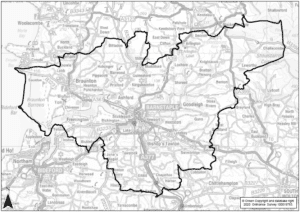Contents
1. Introduction
1.1. Devon County Council is the Waste Disposal Authority and as such is responsible for managing Local Authority Collected Waste (LACW) (formerly known as municipal waste). This includes domestic and low level clinical waste collected from households, waste collected from some commercial sources, waste taken to public recycling centres, street litter and waste from fly tipping.
1.2. The public recycling centres across Devon play an important role in enabling the County Council to meet its statutory responsibility as Waste Disposal Authority. In 2019/20, 89,000 tonnes of waste was managed at these facilities. However, housing and population growth across the county is resulting in increasing demand and pressure upon these facilities. A number of sites are now at capacity and are no longer fit for purpose and therefore require replacement.
1.3. This paper sets out the methodology for calculating financial contributions which will be requested from development in order to improve the network of recycling centres that will manage Devon’s waste and enable the impact of development to be mitigated.
1.4. This policy was updated (January 2021) to provide the most up to date waste figures and reflect the areas in which a replacement site is required as set out in the 2020 Household Waste Recycling Centres Improvement Strategy[1].
2. Background
1.1. For many years, waste management heavily relied on the use of landfill sites. Historically these sites were relatively cheap to use and the geology and topography of the UK were well suited for landfill. In recent years, far more emphasis has been placed on the benefits of recycling. The 2013 Waste Management Plan for England states that by 2020 at least 50% of household waste by weight should be either prepared for re-use or recycled. The 2018 Resources and Waste Strategy for England extends the recycling target to 65% of municipal waste by 2035.
1.2. In 2019/20 annual waste generation in Devon decreased by 0.3% from the previous year and the recycling rate stood at 56.6% which exceeds national targets. Devon County Council is committed to the principle of seeking to reduce the amount of waste generated by society, the re-use of waste materials wherever possible, and the recovery of value from waste, for example, by composting and recycling.
1.3. The Waste and Resource Management Strategy for Devon[1] was published in March 2013. A replacement Resource and Waste Management Strategy is being produced[2]. The strategy will set out what has been achieved in recent years, review changes in legislation to ensure compliance, review waste tonnages and targets and confirm the relevance of strategy policies. The document will also set out the need to replace or improve certain recycling facilities. A new Household Waste Recycling Centres Improvement Strategy was published in 2020 to set out how recycling centres in Devon will be improved in the next 10-15 years.
1.4. The Devon Waste Plan[3] provides the planning policy framework for decisions by Devon County Council on planning applications for waste management development. The Plan covers the period to 2031 and highlights the waste hierarchy. The waste hierarchy displayed in Figure 1 sets out a sequential approach which should be followed in order to achieve sustainable waste management.
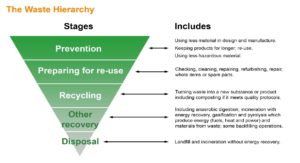
Figure 1: Waste Hierarchy
[1] https://www.devon.gov.uk/wasteandrecycling/waste-management-strategy-for-devon/
[2] https://democracy.devon.gov.uk/documents/s32889/HIW-20-34.pdf
[3] https://www.devon.gov.uk/planning/planning-policies/minerals-and-waste-policy/devon-waste-plan
3. Devon’s recycling centres
1.1. Devon currently has 19 public recycling centres, as displayed in Figure 2, which provide good coverage across the county, with all centres of population having access to a facility. The settlements that currently host these sites are:
- Barnstaple
- Bideford
- Crediton
- Exeter x 2 (Exton Road and Pinbrook)
- Exmouth
- Holsworthy
- Honiton
- Ilfracombe
- Ivybridge
- Kingsbridge
- Newton Abbot
- Okehampton
- Sidmouth
- South Molton
- Tavistock
- Torrington
- Totnes
- Tiverton
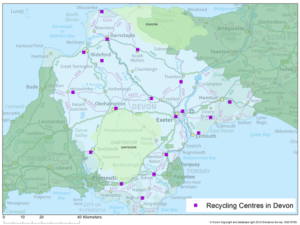
Figure 2: Map showing recycling centres in Devon
4. Justification for replacement sites
1.1. As the number of homes and the population increases, so too does the demand on recycling centres. Over forthcoming years this increased demand will result in the need to replace a number of existing recycling centres. Failure to provide adequate recycling facilities in the context of new development may result in the Council being unable to fulfil its statutory role as Waste Disposal Authority.
1.2. A number of factors influence the conclusion that a site requires replacement. These include:
- Vehicles regularly queuing for access to the site. This can be a result of high demand from the public at particular times meaning more people are attempting to use the site than it has capacity for. Queues can also be the result of the need to regularly remove material from the site due to site layouts that are not fit for purpose and limited storage availability. The action of removing material often means public access is restricted whilst the removal process occurs.
- Site restrictions in terms of scale and layout, which result in operational inefficiencies and a lower than average recycling rate. This relates to the latest requirements for material segregation and therefore results in an increased number of storage units in comparison to those envisaged when the site was acquired / developed.
- The site no longer being fit for purpose in terms of public usability. For example, heavy bulky items may need to be carried up steps and placed into containers, presenting accessibility and health and safety issues.
1.3. Proposed development within an area will impact on all of the factors discussed above as the number of users and amount of material received at the sites increases. This worsening situation will result in the need for a replacement site becoming more acute.
1.4. The Household Waste Recycling Centres Improvement Strategy for Devon, which was adopted in 2020, outlines a series of areas where replacement sites are required in the next 10-15 years. These proposals are:
- Tavistock (and surrounding areas)
- Newton Abbot (and surrounding areas)
- Cullompton / Tiverton / Willand (and surrounding areas)
- Honiton (and surrounding areas)
- Kingsbridge/Totnes/Dartmouth (and surrounding areas);
- Barnstaple (and surrounding areas)
5. Contribution methodology
1.1. Residential development in Devon will lead to an increased demand for the services provided at the County’s recycling centres. National and local initiatives are currently directed towards minimising waste and are aiming for more waste to be reused and recycled. As a Waste Disposal Authority, Devon County Council has a statutory duty under the 1990 Environment Protection Act to provide facilities at which residents can dispose of their household waste.
1.2. As Devon’s population continues to grow, the pressure on recycling centres will increase as more residents use these facilities. Therefore, it is necessary and appropriate for residential development to provide a contribution towards replacing recycling centres where required.
1.3. Contributions will be requested on a ‘per dwelling’ basis. The methodology for calculating the contribution per dwelling is based upon the total cost of the infrastructure and the number of homes the facilities will serve in total.
1.4. The methodology identifies a per dwelling rate for replacement facilities (see below).
Replacement facilities
1.5. As identified in the Household Waste Recycling Centres Improvement Strategy, the County Council has identified the need for six replacement facilities across the County over forthcoming years.
1.6. The cost of providing a new facility is calculated to be £4m (including land costs). This figure is based upon the costs incurred in delivering new facilities in Exeter, Ivybridge and Sidmouth and an assumption that each facility requires a site of 1.5ha. The total cost of the facilities above is £24m.
1.7. An assessment of the catchments served by the replacement recycling centres has been undertaken (catchments identified in Appendix A). This work has assessed the number of homes within the catchments to be served by the recycling centres based on existing homes and planned development as identified in Local Plans[1].
1.8. The facilities outlined will serve a total of 187,663 homes. This takes account of both existing and planned housing development in the catchment areas the sites will serve. By taking account of the cost of new recycling centres and the number of homes they will serve, a contribution of £128 per dwelling has been calculated. This contribution will be sought from development proposals coming forward within the catchment areas identified.
1.9. Where the county council has forwarded funded a replacement facility, contributions will be sought retrospectively towards this.
1.10. In cases of large applications, the county council may negotiate with the developer to provide land in lieu of a financial contribution.
1.11. The county council requests access to the funding for 10 years after the last payment has been made to the County Council. This repayment clause is to be included within Section 106 agreements relating to recycling centre contributions.
Regulations
1.12. This methodology has been developed with regard to Regulation 122 of the Community Infrastructure Levy Regulations (2010) and the NPPF which identify that planning obligations must be:
(a) necessary to make the development acceptable in planning terms;
(b) directly related to the development; and
(c) fairly and reasonably related in scale and kind to the development.
1.13. Each of these requirements and their relationship with the contributions methodology is set out below:
(a) Population growth will have a direct impact upon the demand for recycling centres in Devon. It is therefore necessary and appropriate that developers contribute towards the replacement of these facilities where existing sites cannot accommodate the expected growth. The County Council has a statutory duty to manage household waste in accordance with the waste hierarchy and without developer contributions to mitigate the impact of development, the ability to meet this duty will be compromised.
(b) Contributions will only be sought from development located within a catchment area where a capacity shortfall has been identified. Contributions will therefore directly be used to provide local recycling centre provision for the development in question.
(c) The methodology for calculating recycling centre contributions has been developed by taking into account the number of proposed dwellings, the total number of homes in the catchments in future and the cost of the projects required. This ensures contributions are calculated with specific reference to the scale of development and are therefore proportionate.
[1] Plan period end dates vary.
6. Conclusion
This paper has outlined the methodology which will be applied when calculating developer contributions for recycling centre facilities. The approach embedded within the methodology ensures that requests will be fair and proportionate and related to the scale of development proposed.
Appendix A
Catchment area for a replacement site in Tavistock
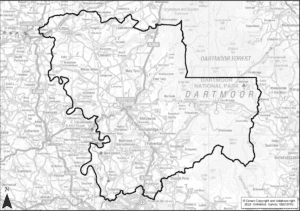
Catchment area for a replacement site in Newton Abbot
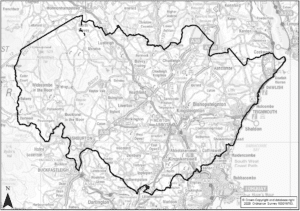
Catchment area for a replacement site in Cullompton / Tiverton / Willand
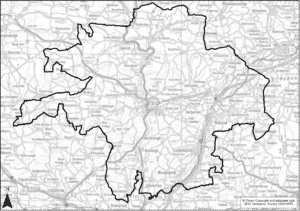
Catchment area for a replacement site in Honiton
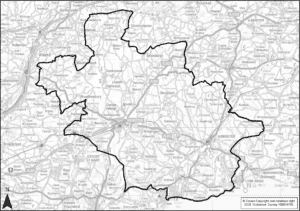
Catchment area for replacement site in Kingsbridge/Totnes/Dartmouth
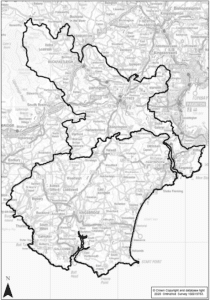
Catchment area for a replacement site in Barnstaple
